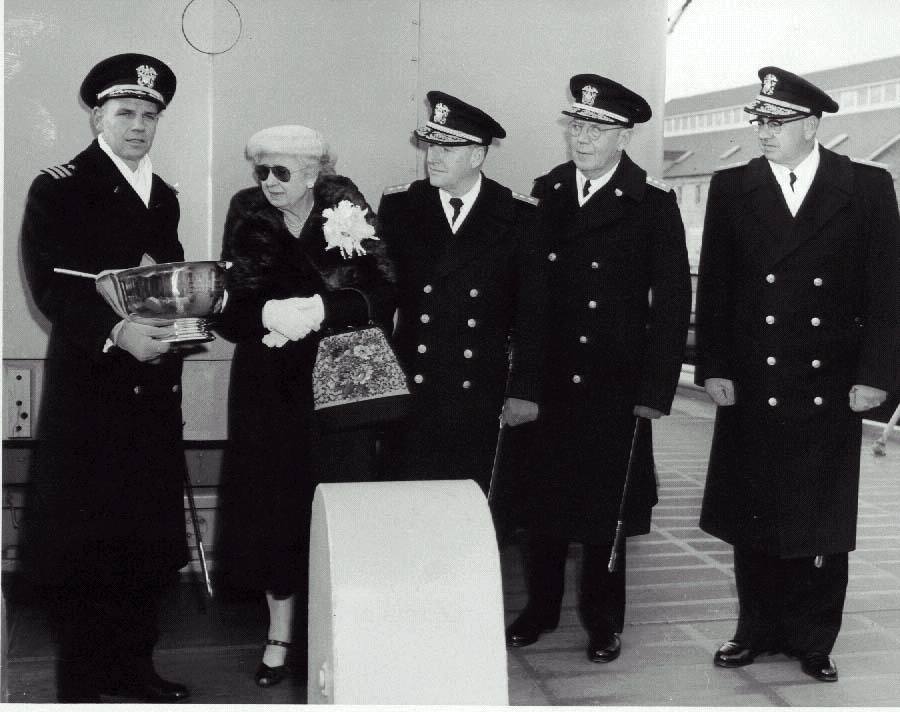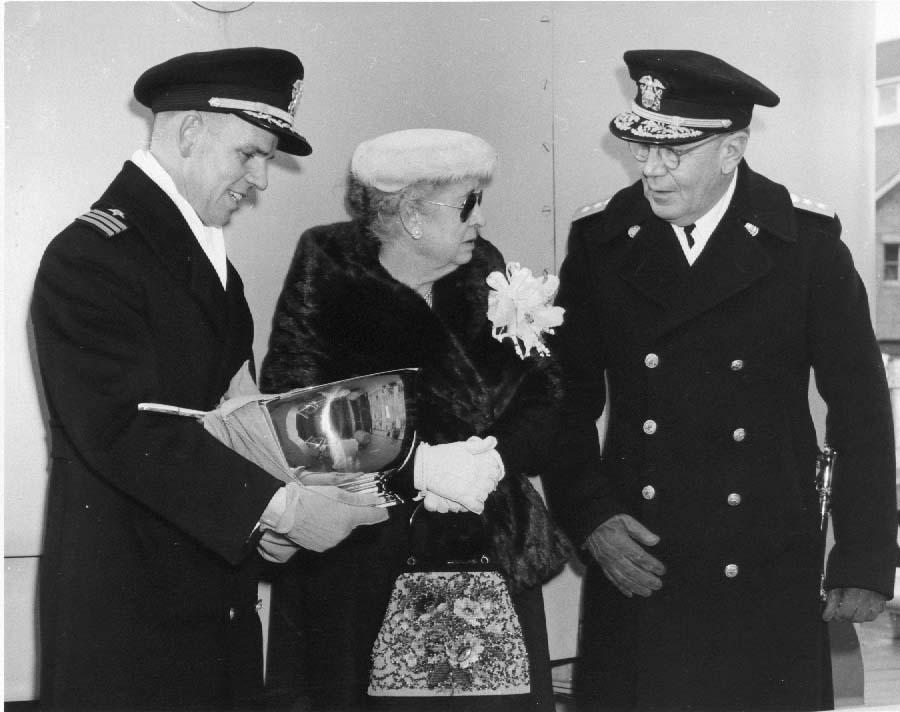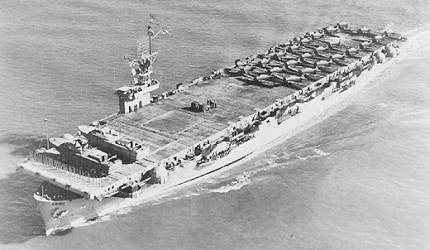
Mrs. Kathryn Mullinnix (Wife of Rear Admiral Henry Maston Mullinnix) Presenting Silver Bowl




 ear Admiral Mullinnix was survived by his wife, Mrs. Kathryn F. Mullinnix (Stockton, California). Mrs. Mullinnix served as sponsor for the destroyer named in honor of her husband, USS Mullinnix (DD-944), and christened the ship with her husbandís name on 18 March 1957.
ear Admiral Mullinnix was survived by his wife, Mrs. Kathryn F. Mullinnix (Stockton, California). Mrs. Mullinnix served as sponsor for the destroyer named in honor of her husband, USS Mullinnix (DD-944), and christened the ship with her husbandís name on 18 March 1957.


 ITKOH BAY was converted from a Maritime Commission hull (MC hull 1123) by the Kaiser Shipbuilding Co., of Vancouver, Washington. Her keel was laid down on 23 November 1943, and she was launched on 19 February 1944; sponsored by Mrs. Kathryn Mullinnix; and commissioned at Astoria, Oreg., on 28 March 1944, Capt. Robert G. Lockhart, USN, in command.
ITKOH BAY was converted from a Maritime Commission hull (MC hull 1123) by the Kaiser Shipbuilding Co., of Vancouver, Washington. Her keel was laid down on 23 November 1943, and she was launched on 19 February 1944; sponsored by Mrs. Kathryn Mullinnix; and commissioned at Astoria, Oreg., on 28 March 1944, Capt. Robert G. Lockhart, USN, in command.
 he spent the month after commissioning completing her fitting out and making short shakedown and trial cruises along the northwestern coast of the United States. On 28 April, the escort carrier entered port at Alameda, Calif., loaded cargo and embarked passengers. She stood out of Alameda on 30 April, bound for Pearl Harbor, and began the first of many routine voyages shuttling planes, pilots, and aircrewmen back and forth between the front line and rear areas. The majority of her missions carried her from Pearl Harbor, or via Pearl Harbor from the California coast, to various islands in the southern or central Pacific which served as staging areas for the war being waged farther north or west. In the latter part of 1944, her ports of call were Majuro in the Marshall Islands, and Manus in the Admiralty Islands. From these two points, planes were staged on to the 3d and 7th Fleets, respectively.
he spent the month after commissioning completing her fitting out and making short shakedown and trial cruises along the northwestern coast of the United States. On 28 April, the escort carrier entered port at Alameda, Calif., loaded cargo and embarked passengers. She stood out of Alameda on 30 April, bound for Pearl Harbor, and began the first of many routine voyages shuttling planes, pilots, and aircrewmen back and forth between the front line and rear areas. The majority of her missions carried her from Pearl Harbor, or via Pearl Harbor from the California coast, to various islands in the southern or central Pacific which served as staging areas for the war being waged farther north or west. In the latter part of 1944, her ports of call were Majuro in the Marshall Islands, and Manus in the Admiralty Islands. From these two points, planes were staged on to the 3d and 7th Fleets, respectively.
 n January 1945, the South Pacific was dropped from SITKOH BAYís itinerary, and she concentrated on replenishing the 3rd Fleet in the Central Pacific. Her ports of call included Apra Harbor, Guam, in the Marianas; Roi Harbor, Roi Island, and Eniwetok Atoll in the Marshalls; and Ulithi Atoll in the Western Carolines. Her missions in early 1945 were in support of the campaigns in the Philippines, the assault on Iwo Jima, and the preparations for the invasion of Okinawa.
n January 1945, the South Pacific was dropped from SITKOH BAYís itinerary, and she concentrated on replenishing the 3rd Fleet in the Central Pacific. Her ports of call included Apra Harbor, Guam, in the Marianas; Roi Harbor, Roi Island, and Eniwetok Atoll in the Marshalls; and Ulithi Atoll in the Western Carolines. Her missions in early 1945 were in support of the campaigns in the Philippines, the assault on Iwo Jima, and the preparations for the invasion of Okinawa.

 ITKOH BAYís only action came on 7 April 1945 while she was delivering Marine Air Group 31 to Okinawa. At 1528, a twin-engined Japanese "Francis" dove at the carrier. SITKOH BAYís antiaircraft gunners combined with a Marine Corsair from BRETONís (CVE 23) combat air patrol to splash the interloper about 100 yards off SITKOH BAYís port beam. The next day, she cleared the area for Guam en route to Pearl Harbor and a return to her replenishment routine.
ITKOH BAYís only action came on 7 April 1945 while she was delivering Marine Air Group 31 to Okinawa. At 1528, a twin-engined Japanese "Francis" dove at the carrier. SITKOH BAYís antiaircraft gunners combined with a Marine Corsair from BRETONís (CVE 23) combat air patrol to splash the interloper about 100 yards off SITKOH BAYís port beam. The next day, she cleared the area for Guam en route to Pearl Harbor and a return to her replenishment routine.
 fter the cessation of hostilities with Japan on 15 August 1945, SITKOH BAY joined Task Group 30.8, the replenishment group for the 3d Fleet, and cruised with it off the southeastern coast of Honshu from 25 August until 5 September. On 10 September, she entered Eniwetok and departed the next day for Guam. For the next month, she made voyages between Guam, Samar Island in the Philippines, and Okinawa, returning to Pearl Harbor on 18 October and San Diego on the 26th for an availability period. After further voyages to the Central Pacific, SITKOH BAY returned to the United States and was placed out of commission, in reserve, on 30 November 1946 at Bremerton, Wash.
fter the cessation of hostilities with Japan on 15 August 1945, SITKOH BAY joined Task Group 30.8, the replenishment group for the 3d Fleet, and cruised with it off the southeastern coast of Honshu from 25 August until 5 September. On 10 September, she entered Eniwetok and departed the next day for Guam. For the next month, she made voyages between Guam, Samar Island in the Philippines, and Okinawa, returning to Pearl Harbor on 18 October and San Diego on the 26th for an availability period. After further voyages to the Central Pacific, SITKOH BAY returned to the United States and was placed out of commission, in reserve, on 30 November 1946 at Bremerton, Wash.
 n 29 July 1950, SITKOH BAY was recommissioned, Capt. C. W. Lord, USN, in command. She was assigned to the Military Sea Transportation Service; and, for the next four years, she sailed between the west coast and Japan, supporting U. N. forces in Korea. Her major ports of call were San Francisco, San Diego, and Pearl Harbor and Yokohama and Yokosuka in Japan. SITKOH BAY departed from this west coast-to-Japan routine three times over those four years. In March of 1951, she delivered a load of Bearcat fighters (F8Fs) to the French forces at Saigon in French Indochina and then visited Manila, P. I., before returning to California-to-Japan runs. In September, she visited Pusan, Korea. SITKOH BAY ventured from her normal sea lanes again IN MAY 1952 when she sailed, via Kodiak and Anchorage, Alaska, on her way back to San Francisco from Yokosuka.
n 29 July 1950, SITKOH BAY was recommissioned, Capt. C. W. Lord, USN, in command. She was assigned to the Military Sea Transportation Service; and, for the next four years, she sailed between the west coast and Japan, supporting U. N. forces in Korea. Her major ports of call were San Francisco, San Diego, and Pearl Harbor and Yokohama and Yokosuka in Japan. SITKOH BAY departed from this west coast-to-Japan routine three times over those four years. In March of 1951, she delivered a load of Bearcat fighters (F8Fs) to the French forces at Saigon in French Indochina and then visited Manila, P. I., before returning to California-to-Japan runs. In September, she visited Pusan, Korea. SITKOH BAY ventured from her normal sea lanes again IN MAY 1952 when she sailed, via Kodiak and Anchorage, Alaska, on her way back to San Francisco from Yokosuka.
 he escort carrier ceased operations again in 1954 and was placed out of commission, in reserve, on 27 July. She joined the Pacific Reserve Fleet and was berthed at San Francisco. On 12 June 1955, the mothballed escort carrier was redesignated a utility aircraft carrier, CVU 86. In mid-March 1958, she changed berthing areas, moving from San Francisco to San Diego. On 1 April 1960, SITKOH BAY, by then reclassified as a cargo ship and aircraft ferry, AKV 30, was struck from the Navy list. Her hulk was sold on 30 August 1960 to Eisenberg & Co., of New York City for scrapping.
he escort carrier ceased operations again in 1954 and was placed out of commission, in reserve, on 27 July. She joined the Pacific Reserve Fleet and was berthed at San Francisco. On 12 June 1955, the mothballed escort carrier was redesignated a utility aircraft carrier, CVU 86. In mid-March 1958, she changed berthing areas, moving from San Francisco to San Diego. On 1 April 1960, SITKOH BAY, by then reclassified as a cargo ship and aircraft ferry, AKV 30, was struck from the Navy list. Her hulk was sold on 30 August 1960 to Eisenberg & Co., of New York City for scrapping.
 ITKOH BAY was awarded three battle stars for World War II service and one battle star for Korean War service.
ITKOH BAY was awarded three battle stars for World War II service and one battle star for Korean War service.
